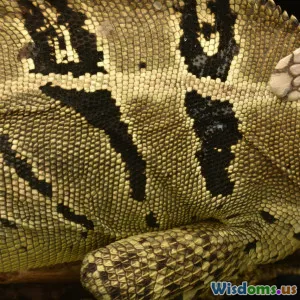
Top 7 Cryptids That Still Evade Scientific Explanation
8 min read Discover 7 mysterious cryptids that continue to baffle scientists and stir imaginations worldwide. (0 Reviews)
Top 7 Cryptids That Still Evade Scientific Explanation
Cryptids—creatures rumored to exist but lacking scientific confirmation—have captivated humanity’s imagination for centuries. From shadowed forests to deep lakes, stories of bizarre and unexplained animals fuel myths and folklore worldwide. Despite advances in biology and technology, some cryptids continue to slip through the fingers of science, teasing skeptics and believers alike.
In this article, we journey through the haunting and intriguing world of seven top cryptids that remain tantalizing mysteries, blending folklore, eyewitness testimonies, and ongoing scientific curiosity.
1. Bigfoot (Sasquatch)
Perhaps the most famous cryptid, Bigfoot is said to roam North American forests, particularly in the Pacific Northwest. Described as a large, bipedal, ape-like humanoid covered in hair, Bigfoot commands both fascination and skepticism.
Why It Evades Science
Comprehensive habitat areas should offer traces—hair, footprints, or clear photographic evidence—but none definitive. Skeptical analyses often cite hoaxes or misidentified wildlife. Yet, the 1967 Patterson–Gimlin film remains, to this day, a startling piece of footage capturing what some firmly believe to be Bigfoot.
Multiple indigenous cultures recount Bigfoot-like entities, suggesting a long-standing folklore. Despite numerous genetic tests on hair samples claiming to come from Bigfoot, results typically link to known animals or contaminants.
2. The Loch Ness Monster (Nessie)
In the misty Scottish Highlands lies Loch Ness, home to the legendary Nessie—a large aquatic creature often depicted as a long-necked plesiosaur-like dinosaur.
Scientific Challenges
Extensive sonar studies, underwater photography, and even environmental DNA sampling, such as the 2018 study scanning for genetic evidence, came up empty on conclusive proof. Alternative scientific analyses propose large sturgeon or other fish misidentified as monsters.
The enduring power of Nessie resides partly in sonar anomalies and countless eyewitness accounts dating back to the 1930s, maintaining its place as arguably the world’s most famous cryptid.
3. Chupacabra
Originating from Latin American folklore, the chupacabra (literally "goat-sucker") is said to be a creature attacking livestock, leaving mysterious puncture wounds.
Scientific Insights
Examinations of alleged chupacabra carcasses often identify them as mangy coyotes, foxes, or dogs affected by mange (a parasitic skin condition that alters their appearance).
Still, sightings persist across multiple countries, characterized by a spiny back or unusual posture. The creature remains a blend of myth and misidentification, raising questions about rural folklore’s role in cryptid creation.
4. Mothman
Emerging from the coal-mining town of Point Pleasant, West Virginia, in the 1960s, Mothman was described as a large, humanoid figure with glowing red eyes and wings.
The Enigma
Witnesses linked the Mothman sightings to impending disaster moments before the collapse of the Silver Bridge in 1967, sparking theories of it being an omen. Despite no physical evidence, the Mothman symbolizes the intersection of folklore, tragedy, and mass psychology.
The cryptid’s cultural imprint endures through books, documentaries, and an annual festival, yet science lacks verifiable explanations beyond misidentified owls or mass hysteria.
5. The Yeti (Abominable Snowman)
The Himalayan Yeti is a legendary ape-like creature said to inhabit the snow-covered mountains of Nepal, Bhutan, and Tibet.
Quest for Evidence
Historical footprints and hair samples touted as Yeti evidence have largely been debunked or linked to known animals like bears. Yet, in 2017, a DNA analysis on purported Yeti samples revealed genetic material from ancient polar bears, suggesting some folklore may contain glimmers of zoological truth.
The Yeti remains a symbol of wilderness mystery, blending stories from Sherpa culture with mountaineers’ encounters.
6. The Jersey Devil
According to Pine Barrens folklore in New Jersey, the Jersey Devil is a winged, hoofed creature with a terrifying scream, blamed for livestock killings and eerie nighttime sounds.
Folklore vs. Fact
Despite centuries-old tales, no scientific evidence has confirmed the creature's existence. The longevity of the legend attests to regional tradition and the mysterious allure of unexplained natural events. Explanations range from escaped exotic animals to exaggerated community stories.
7. The Kraken
A legendary sea monster believed to dwell off Scandinavia, the Kraken is described as a giant squid or octopus capable of dragging entire ships underwater.
Real-World Roots
While the Kraken itself remains mythic, giant squids (Architeuthis dux), once considered mythical, have been documented and measured at lengths up to 43 feet. Historians argue that sailor tales of giant squid encounters embellished into Kraken myths.
The elusive nature of deep-sea creatures allows mystery to thrive, positioning the Kraken at a fascinating crossroads of legend and evidenced species discovery.
Conclusion: The Enduring Fascination with Cryptids
Cryptids like Bigfoot, Nessie, and the Yeti are more than mere stories—they are cultural artifacts reflecting humanity's creativity, fear, and yearning for the unknown. Despite scientific challenges and abundant skepticism, these creatures remain embedded in global folklore, inspiring endless debates, investigations, and narratives.
The pursuit of these cryptids emphasizes science's limits and our persistent curiosity. Whether these creatures exist or represent collective myths shaped by nature and imagination, their stories enrich our understanding of culture, psychology, and the natural world’s mysteries.
As technology advances, perhaps one day, science will catch up—or perhaps some mysteries are meant to endure. Until that moment, the cryptid world beckons explorers, skeptics, and dreamers alike.
References and notable investigations:
- Patterson–Gimlin film analysis, 1967
- Loch Ness Environmental DNA (2018), Nature Communications
- 2017 Yeti DNA research, Proceedings of the Royal Society B
- Various ethnographic sources on folklore
Explore more, remain curious, and keep questioning—the unknown is where adventure begins.
Rate the Post
User Reviews
Popular Posts
















